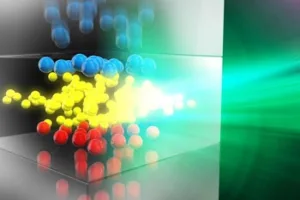OLED-based laser diodes may be within reach soon, thanks to work by a team of American and Japanese researchers. They have found that OLEDs made with finely-patterened structures can produce bright, low-power light sources: a key step in the process.
In the past, organic lasers have been hindered because organic materials tend to operate inefficiently at high currents, which are required for lasing. The researchers say that their key finding was to confine charge transport and recombination to nanoscale areas; this extends electroluminescent efficiency roll-off – the current density at which the efficiency of the OLEDs dramatically decreases – ‘by almost two orders of magnitude’. Heating is suppressed and charge recombination is prevented to achieve this.
By suppressing roll-off, efficiency is increased at high brightness levels, so less power can be used to achieve the same brightness levels.
Charge diffusion in an OLED’s transport region.The production of OLED-based lasers requires very high current densities – thousands of amperes per cm² (kA/cm²); however, until this work, heating limited these densities. Brightness is limited by annihilation processes at high current densities – the electrons in an OLED release light in ways other than filling a hole in a molecule, such as colliding with each other.
The new structures were produced using electron-beam lithography. The small device area supports charge density injection of over 2.8 kA/cm² (previously the team had showed OLED performance at current densities of over 1 kA/cm²), but with luminescent efficiency more than 100 times higher than previous work.
Chihaya Adachi, co-author of the paper, describes OLEDs like a crowded train; when people (electrons) sit in an empty seat (a hole in a molecule), they release energy (light). He said, “In our device structure, we have effectively confined the entrance and exit to the middle of the train. People diffuse to the two less-crowded ends of the train and reduce collisions and annihilation”.

